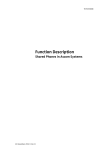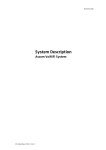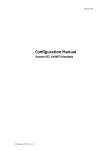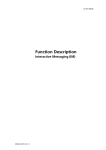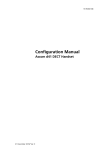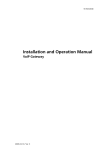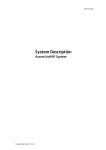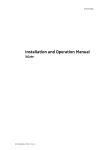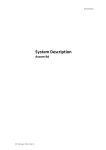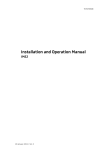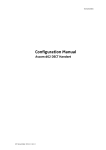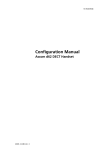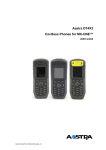Download Function Description Ascom VoWiFi System, TD92314GB
Transcript
TD 92314GB Function Description Ascom VoWiFi System 13 December 2010 / Ver. E Function Description Ascom VoWiFi System TD 92314GB Contents 1 Introduction .................................................................................................................... 1 1.1 Abbreviations and Glossary................................................................................................... 1 2 Technical Solution .......................................................................................................... 3 2.1 Connection to IP-PBX............................................................................................................... 3 2.2 Connection to Traditional Telephony System with the VoIP Gateway ....................... 4 2.3 Ascom VoWiFi Handsets......................................................................................................... 4 2.3.1 Ascom i62 VoWiFi Handset ......................................................................................... 4 2.3.2 Ascom i75 VoWiFi Handset ......................................................................................... 4 2.4 Portable Device Manager Windows Version (WinPDM) ................................................. 5 2.5 IMS2............................................................................................................................................. 5 2.6 Unite CM ..................................................................................................................................... 5 2.7 VoIP Gateway/Gatekeeper..................................................................................................... 5 2.8 WLAN/LAN ................................................................................................................................. 6 3 Functions in Ascom VoWiFi Handsets .......................................................................... 7 3.1 Voice Functions ......................................................................................................................... 7 3.1.1 Two-Party Call ................................................................................................................. 8 3.1.2 In Call Menu...................................................................................................................... 8 3.1.3 Push-To-Talk (PTT) Group Call .................................................................................... 8 3.1.4 Supplementary Services ............................................................................................... 9 3.2 Messaging Functions............................................................................................................ 10 3.2.1 Interactive Messaging................................................................................................ 10 3.2.2 Group Messaging......................................................................................................... 11 3.2.3 Availability Information/Absence........................................................................... 11 3.2.4 Coloured Messaging (i62 VoWiFi handsets) ........................................................ 11 3.3 Mobile Data............................................................................................................................. 11 3.4 Alarm Handling ...................................................................................................................... 11 3.4.1 Push-Button Alarm ..................................................................................................... 11 3.4.2 No-Movement Alarm (i75 VoWiFi handsets) ...................................................... 12 3.4.3 Man-Down Alarm (i75 VoWiFi handsets)............................................................. 12 3.4.4 Alarm with Predefined Data..................................................................................... 12 3.4.5 Automatic Call after Alarm ....................................................................................... 12 3.4.6 Automatic Alarm after Emergency Call ................................................................. 12 3.4.7 Acoustic Location Signal............................................................................................ 12 3.4.8 Location of the VoWiFi Handset.............................................................................. 12 3.5 Presence Management ........................................................................................................ 13 4 System Functions in Ascom VoWiFi Handsets........................................................... 14 4.1 Mobility .................................................................................................................................... 14 4.2 Channel Load Reduction ...................................................................................................... 14 13 December 2010 / Ver. E Function Description Ascom VoWiFi System TD 92314GB 4.3 Power Save ............................................................................................................................. 14 4.4 Shared Phones ....................................................................................................................... 15 4.5 Licensing.................................................................................................................................. 15 4.5.1 Ascom i62 VoWiFi Handsets .................................................................................... 15 4.5.2 Ascom i75 VoWiFi Handsets .................................................................................... 15 5 Related Documents ...................................................................................................... 16 6 Document History ........................................................................................................ 17 13 December 2010 / Ver. E Function Description Ascom VoWiFi System 1 TD 92314GB Introduction The Ascom Voice over Wireless Fidelity (VoWiFi) system provides wireless IP telephony, messaging and alarm functions to enterprise LANs. The VoWiFi system can also interact with Unite and other systems. This document gives a brief description of the functions provided by the VoWiFi system. 1.1 Abbreviations and Glossary AP Access Point: a radio transceiver providing LAN connection to wireless devices. BAM Basic Alarm Manager: a tool in the IMS2/Unite CM that can be used to handle triggered inputs and alarms and user data from handsets. ESS§ Enhanced System Service: Unite modules that handle centralised number planning, remote connection, system supervision, fault handling, group handling, message routing, centralised logging, activity logging, and user access administration. ESSID Extended Service Set Identifier: an alphanumeric string of maximum 32 characters. This string is used as an identifier for the WLAN system. H.323 a set of protocols that enable multimedia communication such as voice and video calls over packet-based networks that do not provide a guaranteed QoS. IMS2 Integrated Wireless Messaging and Services: a Unite module that enables wireless services to and from the VoWiFi handsets in a WLAN system. It also includes the Device Manager. IP Internet Protocol: global standard that specifies the format of packets, and the addressing scheme. PBX Private Branch Exchange: telephone system within an enterprise. PTT Push-To-Talk RADIUS Remote Authentication Dial-In User Service: a standard protocol for authentication servers. SIP Session Initiation Protocol: a signalling protocol for controlling multimedia communication sessions such as voice and video calls over IP. TCP Transmission Control Protocol: standard IP protocol that enables two hosts to establish a connection and exchange streams of data with guarantee of data delivery and that data packets will be delivered in the same order that they were sent. Unite Ascom messaging platform. A generic term for a messaging system that unites different systems, for example System 900, System 9d, and VoWiFi. Unite CM Unite Connectivity Manager: a Unite module that enables messaging and alarm handling in a WLAN system. It also includes the Device Manager. 13 December 2010 / Ver. E 1 Function Description Ascom VoWiFi System TD 92314GB UNS Unite Name Server: Unite module component that holds the Unite number plan and Unite destinations. WinPDM Portable Device Manager Windows Version: a software application for initial configuration of the VoWiFi handsets. WLAN Wireless Local Area Network 13 December 2010 / Ver. E 2 Function Description Ascom VoWiFi System 2 TD 92314GB Technical Solution The Ascom VoWiFi system is built by Ascom-developed hardware and software as well as third-party products. For more information on WLAN/LAN built by third-party products, see 2.8 WLAN/LAN on page 6. The following components are developed by Ascom and provides voice, messaging and alarm functions to a WLAN: • • • • • • VoWiFi handset Portable Device Manager Windows Version (WinPDM) Integrated Wireless Messaging and Services (IMS2) Unite Connectivity Manager (Unite CM) VoIP Gateway (converter between traditional telephony and VoIP) Chargers and Accessories Messages and alarms can be sent between the VoWiFi system and other Ascom messaging systems via the IMS2/Unite CM. Communication with traditional telephony systems is enabled through the VoIP Gateway connected to a PBX. Communication with IP-based telephony systems is enabled through a SIP Proxy Server in the IP-PBX. 2.1 Connection to IP-PBX Figure 1. VoWiFi System Access Points Messaging VoWiFi Handsets Send Send Send Unite modules LAN WinPDM IMS2/ Unite CM A-b us System 900 PSTN IP-PBX Figure 1. System Overview without the VoIP Gateway 13 December 2010 / Ver. E 3 Function Description Ascom VoWiFi System 2.2 TD 92314GB Connection to Traditional Telephony System with the VoIP Gateway Figure 2. VoWiFi System Access Points Messaging VoWiFi Handsets Send Send Send Unite modules LAN WinPDM IMS2/ Unite CM VoIP Gateway PRI Main PBX A-b us System 900 PSTN Figure 2. System Overview with the VoIP Gateway 2.3 Ascom VoWiFi Handsets 2.3.1 Ascom i62 VoWiFi Handset The Ascom i62 VoWiFi handset includes functionality such as wireless telephony, alarm and messaging. The personal alarm includes push-button alarm and emergency alarm. You can send and receive messages, and the handset also supports interactive messaging. This means that you can communicate with external sources such as a building management system, hospital system or a production process system. You can also use the handset for remote control of a machine, a door etc. It supports the WLAN standards IEEE 802.11a/b/g/n. The programming of the handset is described in the Configuration Manual i62 VoWiFi Handset, TD 92675GB. How to manage the functions and settings as a user is described in the User Manual i62 VoWiFi Handset, TD 92599GB. 2.3.2 Ascom i75 VoWiFi Handset The Ascom i75 VoWiFi handset is developed for harsh environments and rough handling, and there is also a version designed for the health care sector. It includes functionality similar to the Ascom i62 VoWiFi handset described above with some exceptions. Alarms activated from the handset optionally includes man-down alarm and no-movement alarm. The handset supports WLAN standards IEEE 802.11b/g. The programming of the handset is described in the Configuration Manual i75 VoWiFi Handset, TD 92431GB. How to manage the functions and settings as a user is described in the User Manual i75 VoWiFi Handset, TD 92319GB. 13 December 2010 / Ver. E 4 Function Description Ascom VoWiFi System 2.4 TD 92314GB Portable Device Manager Windows Version (WinPDM) The WinPDM is a management tool for the VoWiFi handsets. It is a software application that runs on a local Windows PC. It has a Java-based Graphical User Interface (GUI) and a database containing parameters specific for each of the VoWiFi handsets used in the system. Examples of parameters are WLAN system parameters, VoIP service parameters, and Unite service parameters. The WinPDM also enables firmware upgrades. Before a VoWiFi handset is able to access the WLAN and any services, it must be configured with WLAN system specific parameters, for example the ESSID. The parameters are synchronized with the handset via a USB cable connected to a handset cradle (a Desktop Programmer [DP1] for i62 VoWiFi handsets, or a USB Programming Device for i75 VoWiFi handsets). Further information can be found in the document Installation and Operation Manual Portable Device Manager, Windows version, TD 92325GB. Note: For the Ascom i62 VoWiFi handset it is possible to make the initial configuration directly on the handset, see Configuration Manual i62 VoWiFi Handset, TD 92675GB. 2.5 IMS2 Integrated Wireless Messaging and Services (IMS2) is a web-based tool used for device management, messaging and alarm handling. It is based on the ELISE2 hardware. The handset needs a basic parameter setup with the WinPDM, for example WLAN and IP settings, to be able to communicate with the IMS2. Thereafter the IMS2 can be used to remotely edit parameters and update software in the handsets via the air. It saves parameters and software for all handsets in a database. It also synchronises the local phonebook. The VoWiFi handset must log on to the IMS2 to enable the messaging and alarm functions. For more information on the IMS2, see the document Installation and Operation Manual IMS2, TD 92586GB. 2.6 Unite CM Unite Connectivity Manager (Unite CM) is a web-based tool used for device management, messaging and alarm handling. It is also used for the administration of users and groups, for supervision, activity logging, and fault logging. It is a Unite module based on the ELISE3 hardware. It can be used independently but also work in combination with other Unite modules or System 900 modules. Unite CM can be used to remotely edit parameters and update software in the handsets via the air in the same way as IMS2. Also, just as for the IMS2, VoWiFi handsets must log on to the Unite CM to enable the messaging and alarm functions. For more information on the Unite CM, see the document Installation and Operation Manual Unite CM, TD 92735GB. 2.7 VoIP Gateway/Gatekeeper When deploying the VoIP Gateway/Gatekeeper, a number of configuration settings must be defined, for example, how to set up the PRI interface, or how call routing is to be performed. Configuration of the VoIP Gateway is described in the document Installation and Operation Manual VoIP Gateway, TD 92326GB. 13 December 2010 / Ver. E 5 Function Description Ascom VoWiFi System 2.8 TD 92314GB WLAN/LAN There are several vendors providing components needed to deploy a WLAN, such as Access Points (APs), switches, and routers. In order to achieve optimal performance for VoWiFi, the following is recommended: • Quality of Service (QoS) must be implemented on the wireless (802.11e, WMM, WMM Power Save) infrastructure. Wireless QoS must be supported by the wired (802.1p) infrastructure. • The wireless infrastructure should be connected to a switched network (i.e hubs or repeaters should be avoided). For more information on VoWiFi system planning, see the document System Planning Ascom VoWiFi System, TD 92408GB. 13 December 2010 / Ver. E 6 Function Description Ascom VoWiFi System 3 TD 92314GB Functions in Ascom VoWiFi Handsets 3.1 Voice Functions The VoWiFi system uses Voice over Internet Protocol (VoIP) as the technology for transmission of voice. The analog voice signal is converted to a digital voice stream divided into packets and compressed in the VoWiFi handsets before they are sent over the network. The transmission of voice packets between the handset and an IP-PBX, or the VoIP Gateway/Gatekeeper/SIP proxy, is handled by the wireless and wired LAN. The VoIP Gateway from Ascom is a combined gateway/gatekeeper/SIP proxy and is only needed when the network is connected to a traditional ISDN PBX. The gateway converts between traditional digital ISDN-based telephony and Voice over IP-based telephony (H.323 or SIP), as well as compresses and decompresses the voice media stream. The gatekeeper manages the so called H.323 zone, which is a logical collection of all the H.323 VoWiFi handsets within the VoWiFi system. The SIP proxy does the same for SIP. The VoIP Gateway also provides address translation (routing) between internal and external numbering plans and provides admission control, specifying which device can call which number. See the Installation and Operation Manual VoIP Gateway, TD 92326GB, for information on how to install and configure the VoIP Gateway. Figure 3. IMS2/ Unite CM WinPDM RADIUS Server IP Backbone / LAN IP-PBX VoIP Gateway PBX AP AP VoWiFi handset Figure 3. Voice transmission Call from VoWiFi handset Where a call request is sent depends on whether an IP-PBX or a traditional ISDN PBX is used in the VoWiFi system. 1 The VoWiFi handset associates with the closest AP (the AP with the best signal quality and strength). 2 A call request is sent either to the IP-PBX or to the VoIP Gateway. 3 The IP-PBX, or the VoIP Gateway, finds the receiving part and sets up the call. 13 December 2010 / Ver. E 7 Function Description Ascom VoWiFi System 3.1.1 TD 92314GB Two-Party Call A call between two VoWiFi handsets is handled by the IP-PBX when using SIP, and by a Gatekeeper/Gateway feature in the VoIP Gateway for an H.323-based exchange. The IP-PBX or Gatekeeper makes the address translation, from alias to IP address, and sets up the call. The IPI-PBX or Gateway controls signalling and provides translation between the packetbased WLAN and circuit-switched ISDN networks when a VoWiFi handset is calling a nonVoWiFi handset. 3.1.2 In Call Menu i62 VoWiFi handsets: The In Call menu can be reached during an ongoing call by pressing the middle Soft key marked “More”. It gives access to a number of different functions. i75 VoWiFi handsets: The right Soft key can be configured and used as a short-cut to different functions during an ongoing call. These settings are configured by the system administrator. 3.1.3 Push-To-Talk (PTT) Group Call Note: PTT requires a phone number to some type of conference bridge (a specialized type of equipment that links telephone lines). Configured groups are also needed in the system. Groups can be configured in any Unite module that handle groups, refer to 3.2.2 Group Messaging on page 11. A PTT session can be initiated from the VoWiFi handset, or triggered by other events, for example an alarm if an AMS or an XGate is available in the system. Figure 4. Other Unite module Conference bridge 9999 group no. 5 2 group no. LAN 3 5 4 5 1 IMS2/ Unite CM AP 4 Initiation from handset (1) Look-up PTT group (2) 4 Response IMS2/Unite CM (3) Call to Conf. bridge (4) Group call connected (5) Figure 4. PTT session initiated by handset 13 December 2010 / Ver. E 8 Function Description Ascom VoWiFi System TD 92314GB When the handset initiates a PTT session, it sends a message to the IMS2/Unite CM, that includes the phone number to the conference bridge. If a PTT session is triggered by for example an alarm, it is the AMS or XGate that sends the message. (All devices able to initiate a session must know the number to the conference bridge.) When the IMS2/ Unite CM has found the PTT group, it forwards the message to all members in the group, including the initiator if the initiator is a member of the group. When the PTT session is accepted, either manually or automatically, the handset is connected to the number that handles the conference/group calls and all handsets in the PTT group are connected. The mute button on the handset is used for shifting between sending and receiving and the users have the possibility to talk simultaneously. The function is described with more details in Function Description Push-To-Talk (PTT) in VoWiFi System, TD 92493GB. 3.1.4 Supplementary Services The supplementary services are supported by H.323/H.450 and SIP protocol. H.323 SIP H450.1 x Supplementary Services H450.2 x Call Transfer H450.3 x Call diversion H450.4 x Call hold H450.6 x Call Waiting H450.7 x Message waiting indication H450.8 x Calling party name presentation H450.9 – Completion of calls to busy subscriber 13 December 2010 / Ver. E Description 9 Function Description Ascom VoWiFi System 3.2 TD 92314GB Messaging Functions The IMS2/Unite CM is a Unite module that acts as an interface between the VoWiFi system and other modules in the Unite system. The IMS2/Unite CM has a number of features available, for example Basic Alarm Manager and Portable Device Phonebook Service, but can also be expanded with other Unite system features. The IMS2/Unite CM is an optional module in the VoWiFi system. The IMS2/Unite CM contains a dynamic database of all registered VoWiFi handsets. To enable messaging functions between the VoWiFi handsets and the Unite system, the handset logs on to the IMS2/Unite CM. This is done when the handset is switched on and then in intervals. No user administration is needed. All text messages to and from handsets within the VoWiFi system are handled by the IMS2/ Unite CM. Message sending from the VoWiFi Handset Prerequisites: The VoWiFi handset is associated with an AP and has logged in to the IMS2/ Unite CM (the IP address to the IMS2/Unite CM is defined in the handset). 1 The VoWiFi handset sends the message to the IMS2/Unite CM. 2 The IMS2/Unite CM performs a database look-up in the Unite Name Server (UNS) for the receiving part and forwards the message. Figure 5. IMS2/ Unite CM WinPDM RADIUS Server IP Backbone / LAN VoIP Gateway PBX AP AP VoWiFi handset Figure 5. WLAN Infrastructures See Installation and Operation Manual IMS2, TD 92586GB for more information about the IMS2. See Installation and Operation Manual Unite CM, TD 92735GB for more information about the Unite CM. 3.2.1 Interactive Messaging Interactive Messaging (IM) is a function that extends the basic messaging function. It makes it possible for a user of a handset to access information from a client application. When an IM is initiated, a number of choices will be presented on the handset display. By selecting one of these choices, an application-controlled action will take place. An action can be, for example, to open a gate. The IM function is described in detail in the document Function Description Interactive Messaging, TD 92168GB. Note that the document describes the function from the Ascom System 9d point of view. 13 December 2010 / Ver. E 10 Function Description Ascom VoWiFi System 3.2.2 TD 92314GB Group Messaging A message from a VoWiFi handset can be sent to a group of users. The group is defined via the Interface Group menu in the IMS2, via Group ID in ESS, or via Groups in Unite CM. 3.2.3 Availability Information/Absence The VoWiFi handset reports availability status to the system via the Absence function. When put in the charging rack, or when set in Manual Absent mode, the VoWiFi handset can be reported as unavailable. Note that this status is set for messaging functions only. The Absence function is handled by the IMS2/Unite CM, and the Manual Absent mode can be set either from the VoWiFi handset or from the IMS2/Unite CM GUI. 3.2.4 Coloured Messaging (i62 VoWiFi handsets) Messages can be colour-coded to make it easy to, for example, identify the priority/urgency of the message or which department/building the message was sent from. The application that sends the message determines the colour. There are ten different colours to choose from. The application could, for example, be a machine supervision system or a medical care system. 3.3 Mobile Data It is possible to send user data from the handset by pressing a pre-programmed key (Hot key, Soft key, Navigation key1, or Multifunction button1) or selecting a Service. Mobile data can be used for opening a door, starting/stopping a machine etc. The data can either be predefined, or entered after the Hot key/Soft key/Navigation key/Multifunction button is pressed or a Service selected. The message is sent to the IMS2/Unite CM, which distributes it further. 3.4 Alarm Handling The VoWiFi handset can send several types of alarms. The alarms are messages sent to the IMS2/Unite CM. The IMS2/Unite CM then distributes the messages to BAM or to other modules/systems for further actions. For a description of parameter settings and VoWiFi handset alarm keys, see the documents User Manual i62 VoWiFi Handset, TD 92599GB, User Manual i75 VoWiFi Handset, TD 92319GB, and Installation and Operation Manual IMS2, TD 92586GB. 3.4.1 Push-Button Alarm The VoWiFi handset is equipped with a red alarm button. When the alarm button is pressed twice within two seconds, the alarm is activated. An information text is displayed, by default “Personal Alarm”. The alarm is sent to the IMS2/Unite CM, which distributes it further. It is also possible to send a test alarm. Press and hold the alarm button until “Test Alarm” is displayed. Note: This alarm can always be triggered; when speaking, editing settings, or while the phone is locked. 1.Ascom i62 VoWiFi handset 13 December 2010 / Ver. E 11 Function Description Ascom VoWiFi System 3.4.2 TD 92314GB No-Movement Alarm (i75 VoWiFi handsets) The No-movement alarm is automatically sent when the user have not moved for a predefined period of time (default 30 seconds). Seven seconds before the alarm is activated a warning signal sounds and the “No-movement on” icon starts to flash. If the user does not cancel the alarm when the signal sounds, the alarm is sent and “No-movement” is shown in the handset display. The No-movement alarm can be followed by an Acoustic Location Signal (ALS), see section 3.4.7 Acoustic Location Signal. By setting the parameter “Extra delay”, the time before the warning for an alarm can be extended up to ten minutes (default value 30 seconds) and no alarm will be triggered during this time period. When the warning signal sounds, press the Mute button to cancel until the alarm is triggered again. 3.4.3 Man-Down Alarm (i75 VoWiFi handsets) The Man-down alarm will go off when a handset is tilted more than 45° for a predefined period of time (default 30 seconds). Before the alarm is activated a warning signal sounds and the “Man-down alarm on” icon starts to flash. If the user does not cancel the alarm by pressing a key, it is sent and “Man-down Alarm” is shown in the display. The functions ALS and Extra delay can be set for the Man-down alarm in the same way as for the No-movement alarm. 3.4.4 Alarm with Predefined Data Additional data, for example a location code, can be sent along with an alarm. The data must manually be defined and stored by the user. To use the function, one Soft/Hot key in the telephone must be defined as a short-cut to the menu “Edit alarm data”. The stored data is added to all types of alarm at transmission. 3.4.5 Automatic Call after Alarm The VoWiFi handset can be programmed to call a predefined telephone number directly after an alarm. Each alarm type in the handset must be programmed with the specific telephone number. 3.4.6 Automatic Alarm after Emergency Call The VoWiFi handset can be programmed to automatically send an alarm after a call to the emergency number. The emergency number is a specific number that can be set in the handset, usually a country’s single emergency telephone number that allows a caller to contact the emergency services for assistance. 3.4.7 Acoustic Location Signal An alarm can be followed by an Acoustic Location Signal (ALS) to make it easier to physically locate the handset. The ALS is a signal from the handset’s speaker that sounds for a predefined period of time. It is silenced by pressing the Mute button on the handset. 3.4.8 Location of the VoWiFi Handset When an alarm is triggered, the information is sent to the IMS2/Unite CM together with an identification of the current AP used for the transmission. Real time location of the VoWiFi handsets can also be performed with third-party software (for example Ekahau or Cisco location servers), see Function Description Location in Ascom VoWiFi System, TD 92607GB. 13 December 2010 / Ver. E 12 Function Description Ascom VoWiFi System 3.5 TD 92314GB Presence Management Note: Presence management requires a Presence Management system and an NTP server for time and date. Refer to the Data Sheet i62 VoWiFi Handset, TD 92587GB, and Data Sheet i75 VoWiFi Handset, TD 92318GB for supported Presence Management system. All activities are programmed in the Presence Management system, which also includes a list with user name and password for each VoWiFi handset allowed to log in. The same user name and password, and the address to the Presence Management system, must be programmed in the handset. The Presence Management system has a LAN connection to the IMS2/Unite CM. The presence menu option is only available in the VoWiFi handset when it has been programmed with the function and logged into and received the activity list from the Presence Management system. When these criteria are fulfilled, the user has the possibility to manage availability from the handset. Figure 6. AP IMS2/ Unite CM 5 LAN 1 VoWiFi Handsets VoIP Gateway 6 4 2 PBX 3 Presence Management System Requests from handset (1,5) Responses from Presence Mangement System (2,6) Information to PBX (3) Notification (4) Figure 6. Presence Management An activity request (1) is sent to the Presence Management system when the user has selected an activity from the list in the Presence menu, set the time limit for the activity and pressed “OK”. The Presence Management system sends a response (2) with the status (action successful or not), and if successful it sends information (3) to the PBX that this number is occupied and any incoming call to this number is to be forwarded to, for example, the operator, the voice mail box, or another number. The Presence Management system then sends a notification (4) that the availability has been updated to the IMS2/Unite CM. The IMS2/Unite CM forwards the notification to the handset. The handset sends a new request (5) for updated status to the Presence Management system, which sends a response (6) with the active availability status. The handset stores the information and the reason for being absent (for example Meeting), and the return time is shown in the display. 13 December 2010 / Ver. E 13 Function Description Ascom VoWiFi System 4 TD 92314GB System Functions in Ascom VoWiFi Handsets 4.1 Mobility The VoWiFi handset supports adaptive rate fallback, which is activated when moving away from the AP in order to increase the operational range and thereby maintaining optimal speech quality while occupying as few RF resources as possible. Before speech starts to degrade due to low signal strength, the VoWiFi handset starts scanning for other AP’s. The scanning starts well before the sensitivity limit is reached in order to have enough time to perform scanning and handover and still maintain a reasonable fading margin to make up for large fading variations. To limit the handover impact on speech quality, the VoWiFi handset performs active scanning in between transmission/reception of speech frames. This limits the packet loss to a maximum of one packet during a handover, if no external authentication is used. After scanning the best AP is selected, and if the AP meets the criteria of having a signal strength that is 10 dB better than the current AP, handover is initiated. In case of a congested or noisy environment, transmission errors will also cause a scanning/ handover to be initiated. 4.2 Channel Load Reduction When scanning for APs in case of roaming, a standard IEEE 802.11 station will scan all channels. During such a scan the station loads all channels, and the system experience is the same as if there were real traffic present on other channels than 1, 6 and 11, leading to a temporary degradation of performance. The handset has the possibility to select exclusive usage of channels 1, 6 and 11 and thereby reduce the system load of a scan. This also eliminates the problem introduced by usage of adjacent channels. The handset’s roaming performance is well improved, since scanning time is reduced significantly. 4.3 Power Save Battery conservation is obtained through the use of standard IEEE 802.11e Power Save mode (PS-mode). The operation differs in idle and call mode. • • Idle mode When the VoWiFi handset is in idle state, it is in PS-mode and listens for broadcasts/ multicasts/unicasts at an interval which is configurable at the AP. Call mode One of three different modes can be pre-configured depending on the type of handset: - In ACTIVE mode the portable stays active during the call, only signalling PS-mode when scanning different channels in case of roaming. When the call is ended, it returns to idle mode (PS-mode). - In U-APSD mode the portable is in PS-mode also during the call. The U-APSD functionality is negotiated with the AP during association and provides the automatic release of buffered packets immediately after an uplink packet. U-APSD maximizes battery lifetime and performance. For use of U-APSD it must be supported by the WLAN infrastructure. 13 December 2010 / Ver. E 14 Function Description Ascom VoWiFi System TD 92314GB - In PS-POLL mode (i75 VoWiFi handsets only) the AP buffers all speech packets destined to the phone. The phone retrieves the packets by transmitting a PS-POLL frame. Those frames are transmitted at the same time as the phone transmits its outgoing speech packet to minimize the awake time. The PS-POLL mode is not part of normal IEEE 802.11 operations. However, the procedure does not violate the standard and should be supported by all IEEE 802.11-compliant APs. Note: PS-POLL mode requires a well-designed PS operation at the AP to function well. 4.4 Shared Phones The shared phone feature allows a group of user to share handsets in the system and still have their own individual settings, such as volume, alarm parameters, and local phonebook. The handset has a virtual SIM card stored apart from the handset, and the settings are retrieved to the handset when the user logs on to the system. The function is described in Function Description Shared Phones in Ascom Systems, TD 92468GB. 4.5 Licensing 4.5.1 Ascom i62 VoWiFi Handsets The three versions i62 Talker, i62 Messenger, and i62 Protector use the same hardware and software, but features are enabled by licensing. The Talker version has a basic license that enables basic functionality, and the Messenger and Protector versions have licenses that enable additional functionalities such as messaging and alarm, respectively. It is possible to upgrade a handset by downloading a license from the License Web. The following licenses are available: • • • • i62 Messenger license i62 Protector license Shared Phone license Location license The function is described in Function Description Product Licensing Overview, TD 92677GB. 4.5.2 Ascom i75 VoWiFi Handsets As default the basic alarm types (Push-button alarm, Test alarm, and Emergency alarm) are available for the user. For optional alarm features (No-movement and Man-down alarm) and location features the i75 VoWiFi handset requires a license. The license is activated from the i75 home page. 13 December 2010 / Ver. E 15 Function Description Ascom VoWiFi System 5 TD 92314GB Related Documents System Description Ascom VoWiFi System TD 92313GB System Planning Ascom VoWiFi System TD 92408GB Data Sheet i62 VoWiFi Handset TD 92587GB User Manual i62 VoWiFi Handset TD 92599GB Quick Reference Guide i62 VoWiFi Handset TD 92597GB Configuration Manual i62 VoWiFi Handset TD 92675GB Data Sheet i75 VoWiFi Handset TD 92318GB User Manual i75 VoWiFi Handset TD 92319GB Quick Reference Guide i75 VoWiFi Handset TD 92320GB Configuration Manual i75 VoWiFi Handset TD 92431GB Data Sheet IMS2 TD 92585GB Installation and Operation Manual IMS2 TD 92586GB Data Sheet Unite CM TD 92739GB Installation and Operation Manual Unite CM TD 92735GB Data Sheet Portable Device Manager, Windows version TD 92324GB Installation and Operation Manual Portable Device Manager, Windows version TD 92325GB Data Sheet VoIP Gateway TD 92323GB Installation and Operation Manual VoIP Gateway TD 92326GB Function Description Interactive Messaging TD 92168GB Function Description Shared Phones in Ascom Systems TD 92468GB Function Description Push-To-Talk (PTT) in VoWiFi System TD 92493GB Function Description Location in Ascom VoWiFi System TD 92607GB Function Description Product Licensing Overview TD 92677GB 13 December 2010 / Ver. E 16 Function Description Ascom VoWiFi System 6 TD 92314GB Document History For details in the latest version, see change bars in the document. Version Date Description A 7 July 2006 First version B 10 November 2006 Handset functions added C 21 October 2007 Following chapters are added: • 3.1.3 Push-To-Talk (PTT) Group Call on page 8 • 3.5 Presence Management on page 13 • 4.4 Shared Phones on page 15 D 29 September 2008 Added a reference to Function Description Location in Ascom VoWiFi System, TD 92607GB, in chapter 3.4.8 Location of the VoWiFi Handset. E 13 December 2010 13 December 2010 / Ver. E • Replaced IMS/IP-WiFi with IMS2 throughout. • Added Unite CM throughout. • Added SIP Proxy Server and removed Portable Device Manager, System version, in chapter 2 Technical Solution on page 3. • Added the Ascom i62 VoWiFi handset in chapter 2.3 Ascom VoWiFi Handsets on page 4. • Changed the parameter examples and added DP1 in chapter 2.4 Portable Device Manager Windows Version (WinPDM) on page 5. • Added device management in chapter 2.5 IMS2 on page 5. • Removed VLAN from 2.8 WLAN/LAN on page 6. • Changed the description in chapter 3.1 Voice Functions on page 7. • Clarified the difference between H.323 and SIP in chapter 3.1.1 Two-Party Call on page 8. • Added In Call menu for the Ascom i62 VoWiFi handset in 3.1.2 In Call Menu on page 8. • Added chapter 3.2.4 Coloured Messaging (i62 VoWiFi handsets) on page 11. • Added that PS-POLL is only used by i75 VoWiFi handsets in chapter 4.3 Power Save on page 14. • Added chapter 4.5 Licensing on page 15. 17




















